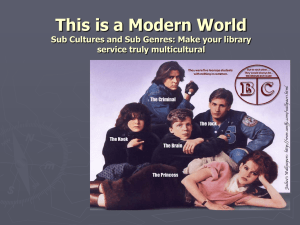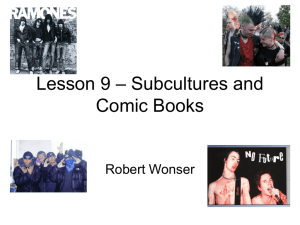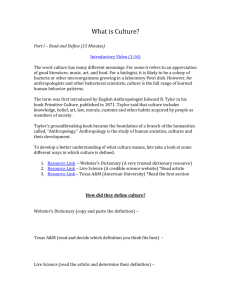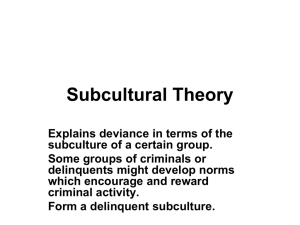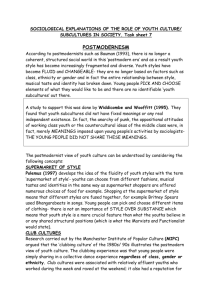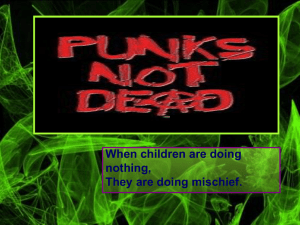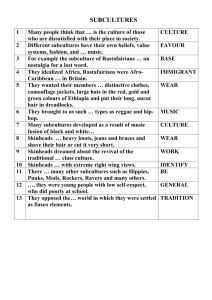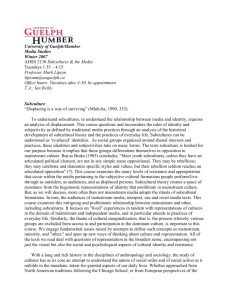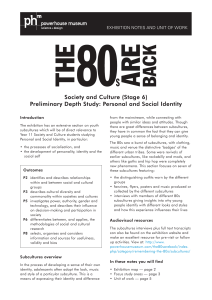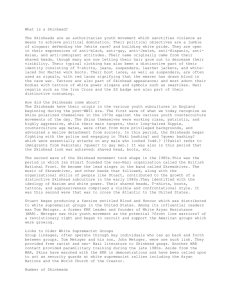Marxist and youth handout 2014
advertisement
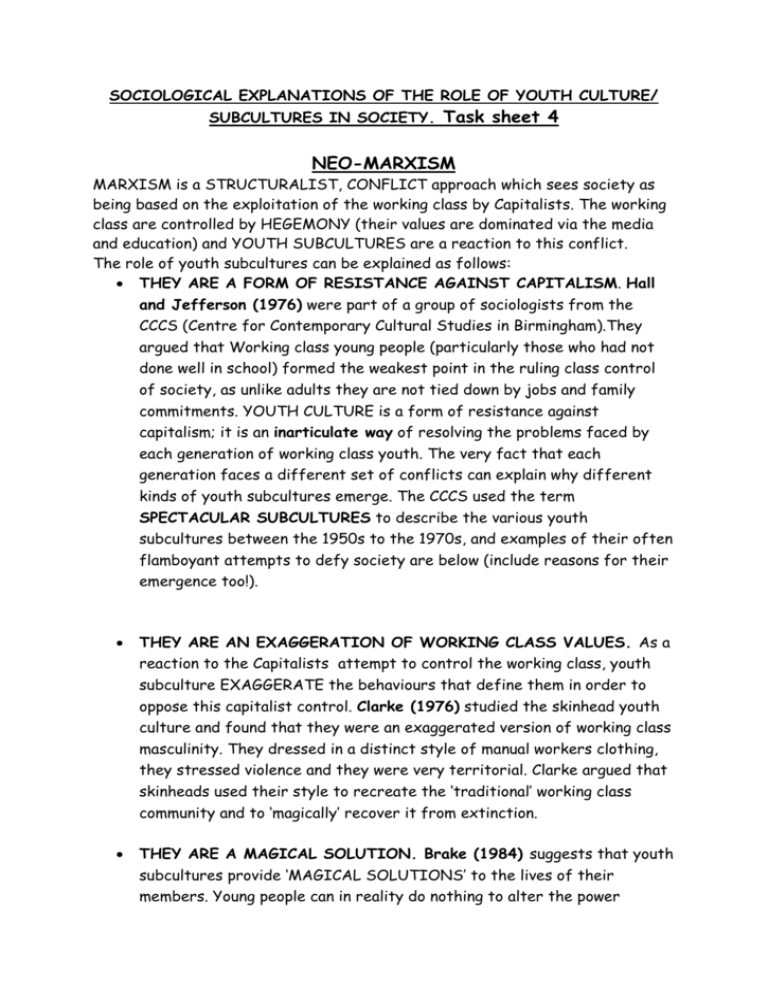
SOCIOLOGICAL EXPLANATIONS OF THE ROLE OF YOUTH CULTURE/ SUBCULTURES IN SOCIETY. Task sheet 4 NEO-MARXISM MARXISM is a STRUCTURALIST, CONFLICT approach which sees society as being based on the exploitation of the working class by Capitalists. The working class are controlled by HEGEMONY (their values are dominated via the media and education) and YOUTH SUBCULTURES are a reaction to this conflict. The role of youth subcultures can be explained as follows: THEY ARE A FORM OF RESISTANCE AGAINST CAPITALISM. Hall and Jefferson (1976) were part of a group of sociologists from the CCCS (Centre for Contemporary Cultural Studies in Birmingham).They argued that Working class young people (particularly those who had not done well in school) formed the weakest point in the ruling class control of society, as unlike adults they are not tied down by jobs and family commitments. YOUTH CULTURE is a form of resistance against capitalism; it is an inarticulate way of resolving the problems faced by each generation of working class youth. The very fact that each generation faces a different set of conflicts can explain why different kinds of youth subcultures emerge. The CCCS used the term SPECTACULAR SUBCULTURES to describe the various youth subcultures between the 1950s to the 1970s, and examples of their often flamboyant attempts to defy society are below (include reasons for their emergence too!). THEY ARE AN EXAGGERATION OF WORKING CLASS VALUES. As a reaction to the Capitalists attempt to control the working class, youth subculture EXAGGERATE the behaviours that define them in order to oppose this capitalist control. Clarke (1976) studied the skinhead youth culture and found that they were an exaggerated version of working class masculinity. They dressed in a distinct style of manual workers clothing, they stressed violence and they were very territorial. Clarke argued that skinheads used their style to recreate the ‘traditional’ working class community and to ‘magically’ recover it from extinction. THEY ARE A MAGICAL SOLUTION. Brake (1984) suggests that youth subcultures provide ‘MAGICAL SOLUTIONS’ to the lives of their members. Young people can in reality do nothing to alter the power differences in society, but joining a subculture allows them the opportunity to convince themselves that their generation will be different to their parents. It is ‘magical’ because it is simply an illusion- a trick that will not be sustained in reality. During the 1970s and early 1980s, most sociological attention was paid to the concept of deviant youth 'subcultures'- the idea that some young people belonged to groups with their own norms, values, rituals, sanctions and dress codes that were antagonistic to mainstream culture, e.g. mods, rockers, etc. In the 1970s, the question of class divisions within youth cultures was examined by Marxist writers especially those associated with the Centre for Contemporary Cultural Studies (CCCS). Marxists see working-class youth cultures as linked to the decline of working-class inner-city communities. These cultures are seen as an attempt to symbolically or 'magically' re-create traditional notions of working-class community through dress, style and behaviour. Moreover, such styles allegedly represent a form of working-class ideological or cultural resistance to ruling-class hegemony (i.e. cultural dominance). Example 1: Teddy Boys • • • Hall and Jefferson argued that the rise of the Teddy Boy in the early 1950s coincided with the expansion of employment and a general rise in affluence. However, Teddy Boys were mainly those youths who had been excluded from this. Their clothing style of the middle class Edwardian ‘Dandy’ jacket was an attempt to show their contempt for the class system by copying the style of their so-called ‘superiors’. Example 2: Skinheads Cohen and Clarke argued that skinhead gangs in the early 1970s were an exaggerated attempt to re-create traditional notions of working-class community which were in decline because of recession in traditional working-class industries and slum clearance. The response of skinhead youth was to stress traditional elements of working class culture through their value system, dress and behaviour and to organise themselves collectively in gangs which emphasised loyalty, toughness, masculinity and aggressive defence of territory. Aspects of skinhead style were borrowed from manual work (e.g. the Doc Marten industrial boots, braces, the haircut, etc.) and symbolised an aggressive resistance to those elements seen as threatening the working-class community, such as immigrants and property developers. As such, skinhead subculture could be seen as an attempt to preserve a working class identity which was felt to be under threat. Example 3: Punk rock Hebdige argued that punk was a form of resistance to a society that was interpreted by youth as being in social, moral and economic decline and conformist and lacking in imagination. Hebdige argues that punk style took conventional items such as safety pins, razor blades, etc. and deliberately used them to shock mainstream society by wearing them as fashion accessories. Punk subculture was short-lived because commodity incorporation commercialised aspects of punk style into commodities to be bought and sold as mainstream fashion and ideological incorporation trivialised punk style through media articles suggesting punks were merely confused youngsters going through a phase. Middle class youth and resistance (i) (ii) Middle class youth do participate in some of the spectacular youth subcultures and there are some spectacular youth subcultures that are largely middle class. They tend to agree about the importance of the ‘self’. Self-development, individualism and could either involve active political opposition such as the young CNDers in the 1960s or the students in 1968 and later in the mid 1970s and more recently the school students against the war or withdrawal from society such as the beats and later the hippies. The latter share some similarities with the young who join New Religious Movements. All of these subcultures have a counter cultural tendency, they have a system of values that are in opposition to the dominant ideology and value system of the time. Brake (1977) Hippies and Skinheads Studied hippies and found they were a relatively wellorganised subculture comprising largely of students and ex-students. They lived on benefits or student grants. They were full of contradictions according to Brake for example they (a) (b) (c) were disdainful of technology (the hippy trail to India) but yet listened to music on big sound systems or stereos. Rejected impure foods but took synthesised street drugs Rejected materialism but needed benefits EVALUATION Muggleton (2000) has argued that much of the CCCS work assumed that youth subcultures of the 1960s and 70s were from the working class. Hippies for example were seen as a middle class subculture, and there is little explanation why these young people who were not necessarily so disconnected from society may have joined. Marxists have been accused of ignoring the importance of ETHNICITY in their study of youth subculture. Class is not the only form of inequality in society, and certain ethnic groups have formed youth subcultures as a reaction to inequalities that they perceive to be unique to them. For example, Rastafarianism gave political expression to the feelings of oppression felt by many Afro Caribbean migrants and their children; the racism they experiences in the 1970s was clearly not experienced by all disadvantaged groups. McRobbie (1991) has argued that critical sociologists have largely ignored the role of girls in subcultures. MALESTREAM sociologists have failed to notice that girls do not ‘fit in’ with their description of the role of subcultures despite the fact that they too are a member of the working class. FUNCTIONALISTS would argue that Marxists exaggerate the concept of RESISTANCE. They would agree that young people join subcultures for a purpose, but according to Eisenstadt (1956) this is simply an attempt to carve out an identity for themselves rather than relying on the ascribed identity of being the child of a particular adult. POSTMODERNISTS see the Marxist explanation as outdated. Today’s youth subcultures no longer have a clear purpose. Maffesoliuses the term NEO TRIBES to explain that young people’s ‘groupings’ today are for the sole purpose of shared friendship and they do not have a ‘collective purpose’ at all. Describe the studies below Jefferson’s study of Teddy Boys: Clarke and Cohen’s study of Skinheads: Hebdige’s study of punks Questions: 1. Describe two reasons why youth cultures emerge according to Marxists 2. Explain some evidence that supports this view 3. What other explanations could there be? 4. Why does Brake describe youth cultures as ‘magical solutions’? 5. What is meant by counter-cultural tendencies? 6. Why were the hippies full of contradictions? 7. Why do you think youth cultures are perceived as deviant?

